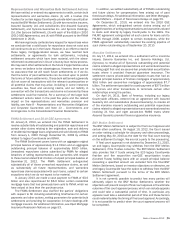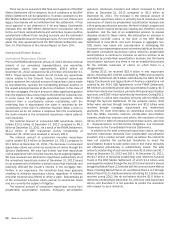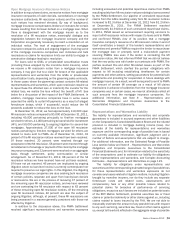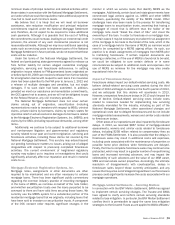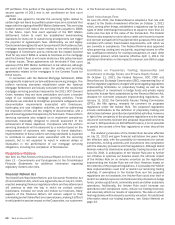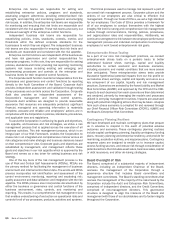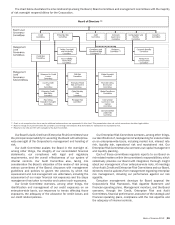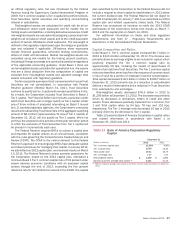Bank of America 2012 Annual Report Download - page 63
Download and view the complete annual report
Please find page 63 of the 2012 Bank of America annual report below. You can navigate through the pages in the report by either clicking on the pages listed below, or by using the keyword search tool below to find specific information within the annual report.Bank of America 2012 61
Derivatives
The Financial Reform Act includes measures to broaden the scope
of derivative instruments subject to regulation by requiring clearing
and exchange trading of certain derivatives; imposing new capital,
margin, reporting, registration and business conduct requirements
for certain market participants; and imposing position limits on
certain over-the-counter (OTC) derivatives. The Financial Reform
Act grants the CFTC and the SEC substantial new authority and
requires numerous rulemakings by these agencies. Swap dealers
conducting dealing activity with U.S. persons above a specified
dollar threshold were required to register with the CFTC on or before
December 31, 2012. We registered BANA, Merrill Lynch
Commodities Inc., Merrill Lynch Capital Services Inc., Merrill Lynch
Financial Markets Inc., Merrill Lynch International and Merrill Lynch
International Bank Limited as swap dealers on December 31,
2012. Upon registration, swap dealers became subject to
additional CFTC rules relating to business conduct and reporting,
and will continue to become subject to additional CFTC rules as
and when such rules take effect. Those rules include, but are not
limited to, measures that require clearing and exchange trading
of certain derivatives, new capital and margin requirements for
certain market participants, and additional reporting requirements
for derivatives under the jurisdiction of the CFTC. The CFTC also
granted relief from some of the rules that would have become
effective during the fourth quarter of 2012, either completely
suspending or delaying the application of some requirements.
While the CFTC has provided temporary exemptive relief from
application of derivatives requirements of the Financial Reform Act
for certain non-U.S. derivatives activity, there remains some
uncertainty as to how the derivatives requirements of the Financial
Reform Act will apply to non-U.S. derivatives activity because the
CFTC has not yet adopted final cross-border guidance. The CFTC
has completed much of its other rulemakings, with the exception
of final margin, capital and exchange trading rules, while the SEC
has finalized a small number of clearing-related rules. The ultimate
impact of the derivatives regulations that have not yet been
finalized and the time it will take to comply remain uncertain. The
final regulations will impose additional operational and compliance
costs on us and may require us to restructure certain businesses
and may negatively impact our results of operations.
FDIC Deposit Insurance Assessments
The FDIC has broad discretionary authority to increase
assessments on large and highly complex institutions on a case
by case basis. Any future increases in required deposit insurance
premiums or other bank industry fees could have an adverse
impact on our financial condition and results of operations.
Resolution Planning
The Federal Reserve and the FDIC require that the Corporation
and other bank holding companies (BHCs) with assets of $50
billion or more, as well as companies designated as systemically
important by the Financial Stability Oversight Council, submit
annually their plans for a rapid and orderly resolution in the event
of material financial distress or failure.
A resolution plan is intended to be a detailed roadmap for the
orderly resolution of the BHC and material entities pursuant to the
U.S. Bankruptcy Code under one or more hypothetical scenarios
assuming no extraordinary government assistance. If the FDIC and
the Federal Reserve determine that our plan is not credible and
we fail to cure the deficiencies in a timely manner, the FDIC and
the Federal Reserve may jointly impose more stringent capital,
leverage or liquidity requirements or restrictions on growth,
activities or operations of the Corporation. We submitted our initial
plan in 2012, which is to be updated annually.
Similarly, in the U.K., the Financial Services Authority (FSA) has
issued proposed rules requiring the submission of significant
information about certain U.K. incorporated subsidiaries and other
financial institutions, as well as branches of non-U.K. banks
located in the U.K. (including information on intra-group
dependencies, legal entity separation and barriers to resolution)
to allow the FSA to develop resolution plans. As a result of the
FSA review, we could be required to take certain actions over the
next several years which could impose operational costs and
potentially result in the restructuring of certain business and
subsidiaries.
Orderly Liquidation Authority
Under the Financial Reform Act, when a systemically important
financial institution such as the Corporation is in default or danger
of default, the FDIC may be appointed receiver in order to conduct
an orderly liquidation of such systemically important financial
institution. In the event of such appointment, the FDIC could invoke
a new form of resolution authority, the orderly liquidation authority,
instead of the U.S. Bankruptcy Code, if the Secretary of the
Treasury makes certain financial distress and systemic risk
determinations. The orderly liquidation authority is modeled in part
on the Federal Deposit Insurance Act, but also adopts certain
concepts from the U.S. Bankruptcy Code.
The orderly liquidation authority contains certain differences
from the U.S. Bankruptcy Code. Macroprudential systemic
protection is the primary objective of the orderly liquidation
authority, subject to minimum threshold protections for creditors.
Accordingly, in certain circumstances under the orderly liquidation
authority, the FDIC could permit payment of obligations it
determines to be systemically significant (e.g., short-term
creditors or operating creditors) in lieu of paying other obligations
(e.g., long-term creditors) without the need to obtain creditors’
consent or prior court review. The insolvency and resolution
process could also lead to a large reduction or total elimination
of the value of a BHC’s outstanding equity. For example, the FDIC
could follow a “single point of entry” approach and replace a
distressed BHC with a bridge holding company, which could
continue operations and result in an orderly resolution of the
underlying bank, but whose equity is held solely for the benefit of
creditors of the original BHC. Additionally, under the orderly
liquidation authority, amounts owed to the U.S. government
generally receive a statutory payment priority.
Credit Risk Retention
On March 29, 2011, federal regulators jointly issued a proposed
rule regarding credit risk retention that would, among other things,
require sponsors to retain at least five percent of the credit risk
of the assets underlying certain ABS and MBS securitizations and
would limit the ability to transfer or hedge that credit risk. The
proposed rule as currently written would likely have an adverse
impact on our ability to engage in many types of the MBS and ABS
securitizations conducted in CRES, Global Markets and other
business segments, impose additional operational and
compliance costs on us, and negatively influence the value,
liquidity and transferability of ABS or MBS, loans and other assets.
However, it remains unclear what requirements will be included in


